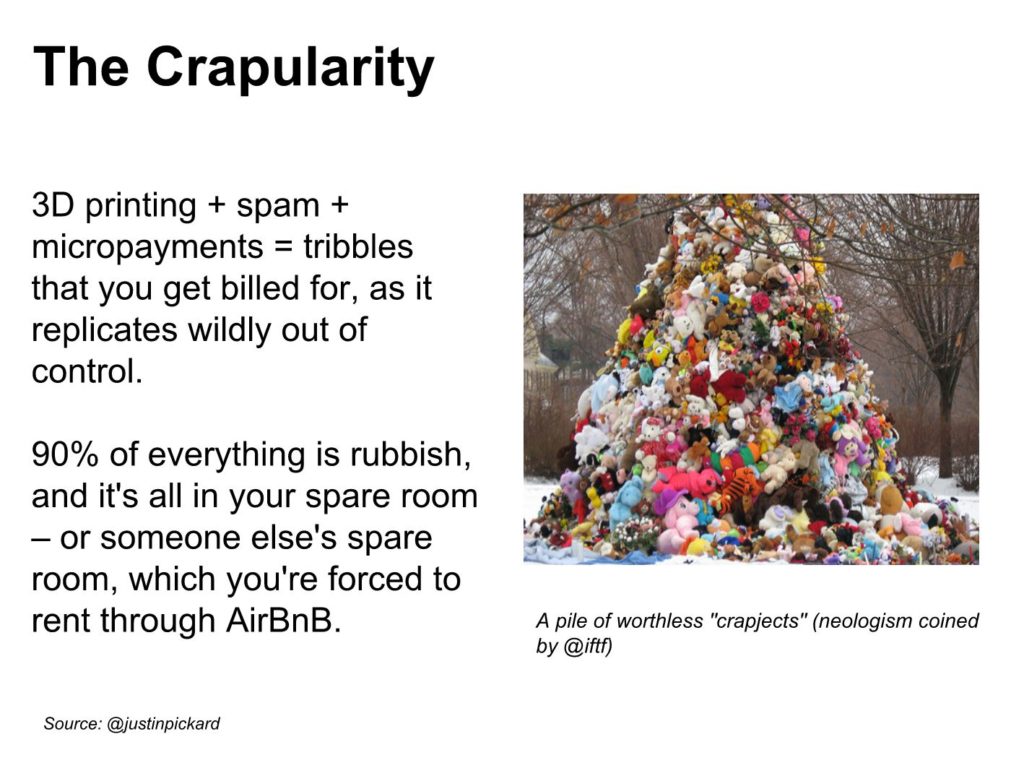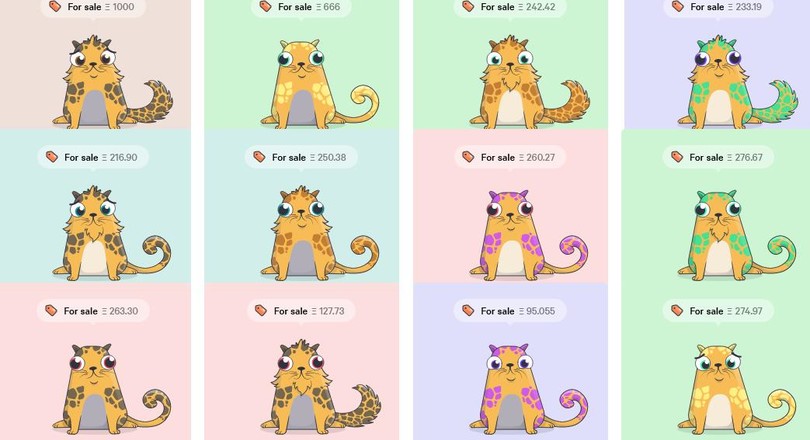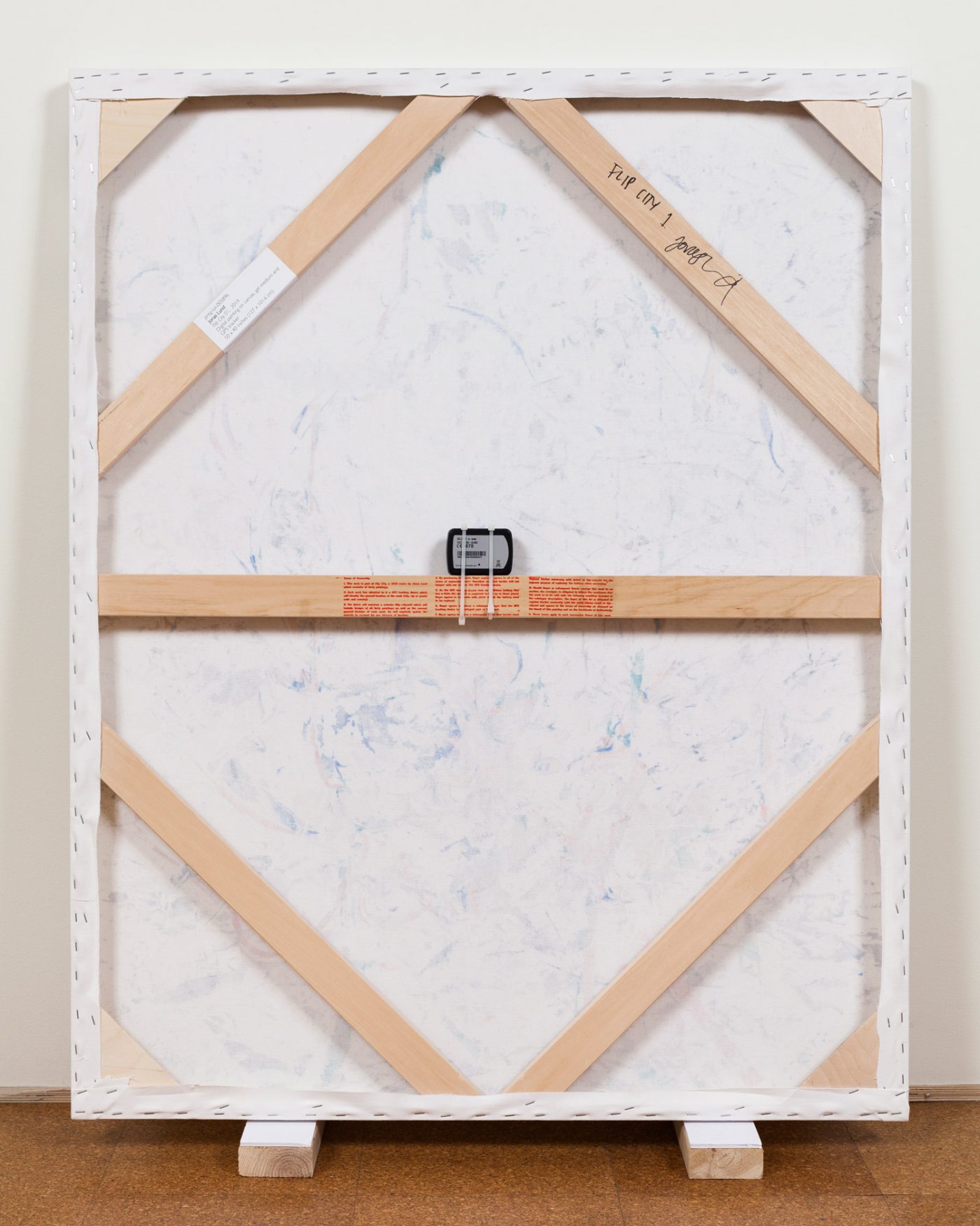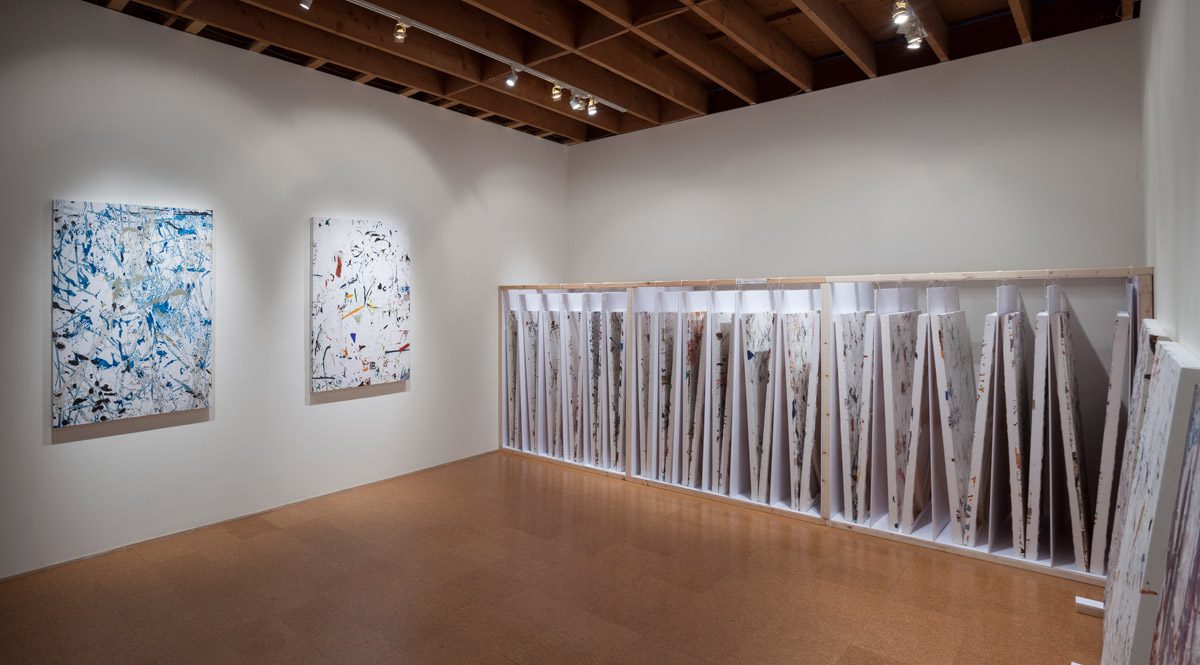In 2011, a loose group of “grumpy futurists” wrote up an extensive list of “Alternatives to the Singularity” in a collaborative Google Document. “The Singularity”, in popular culture and para-religious belief, refers to the point where machine intelligence leaves humans behind. Against the techno-utopian Singularity gospel, the grumpy futurists sketched dystopian visions such as the “Songularity” where ubiquitous auto-tune software will not only manipulate all music, but also every spoken voice.1 Many of those alternative singularities have become true in the meantime, such as the “Re-Bootularity” where all “future movies will either be a re-boot, OR re-boot of a re-boot, re-boot with a twist, prequel or sequel of an existing movie,” or the “Droneularity” where drones encroach everything from “Pakistan, to the U.S./Mexico border, and soon, your local 7/11 parking lot”.2
The fifty alternative singularities sketched in the document are all potentially surmised by one of them: the “Crapularity”, if one broadly understands Crapularity as everything that is about to go wrong in the “Singularity”. In the collective document, the anthropologist Justin Pickard defines it more specifically as:
3D printing + spam + micropayments = tribbles that you get billed for, as it replicates wildly out of control. 90% of everything is rubbish, and it’s all in your spare room – or someone else’s spare room, which you’re forced to rent through AirBnB.3

If one pushes aside technological details like 3D printing and Airbnb storage, then the Crapularity also describes collections of gallery and museum art that pile up in the spare rooms of the art system, i.e. the museum depots whose size continually grows in relation to exhibition space, and the tax-free airport storage facilities that private collectors use today. Withdrawal from public view is the necessary precondition for maintaining the fiction of scarcity upon which the conventional art market relies, without which its inflated prices could not be justified.
In a general sense, the Crapularity is a form of accumulation of capital. Since this capital consists of “rubbish”, the Crapularity reenacts the subprime mortgage crisis and its financialization of default-risky credit and junk assets. In combination with newer digital technologies, contemporary art thus becomes “fintech”, that is, “financial technology” developed outside traditional banking and asset management arenas.

From the article "‘Forever Rose’ Shares The Coding Love With Kids", available here.
On Valentine’s Day of 2018, the digital photograph Forever Rose became the “world’s most valuable piece of virtual artwork ever sold”.4 It raised more than $1 million from a group of ten buyers who had bought it with two cryptocurrencies. One of the two currencies was created by the photographer of the picture, Kevin Abosch, himself. According to the press release, “Forever Rose is an ERC20 token called ROSE on the Ethereum blockchain that is based on Mr Abosch’s photograph of a rose. The buyers each receives [sic] 1/10 of the ROSE token, as ERC20 tokens are divisible. They can then choose to hold their portion, sell it, or give it as a special gift for Valentine’s Day or any other special occasion”.5
The combination of Blockchain technology hype and stock photography kitsch makes it easy to dismiss Forever Rose. On first sight, it is crapular material for future camp shows of late 2010s bad taste. Aside from this specific (admittedly crappy) example, blockchain technology has become a subject of serious discussion in contemporary art, first through the efforts of London’s non-profit art organization Furtherfield and later by master curator Hans Ulrich Obrist via his interview with Ethereum blockchain founder Vitalik Buterin in the spring 2018 issue of TANK Magazine6. Forever Rose thus proves and even eclipses the “strange new future” that an article in the October 2017 issue of ArtReview had predicted, a future in which “art collectors and dealers will no longer worry about buying, selling, shipping and storing artworks. Instead, such works will all disappear into freeport vaults, while galleries and investors speculate on the rising value of a Jeff Koons or a Gerhard Richter, trading blockchain certificates with each other”.7 Forever Rose did not even need to be stored in a freeport vault, since it is a digital photograph that has not even been printed.
Updated through fintech, the contemporary art market may finally catch up with contemporary capitalism: Buyers will be able to “short” an art work or artist, such as Jeff Koons and Liam Gillick, by betting on their future loss of value. The number of art buyers will greatly increase when ownership no longer entails possession of an entire artwork, but only of shares traded on stock markets. In this light, Forever Rose could be seen as the first example of an emerging subprime art market. There will be derivatives of these stocks, such as credit default swaps, as they already exist for cryptocurrencies.
Until recently, the contemporary art market was based on the same economic principles from the 16th to 19th century, with oligarchs accumulating artworks as their private material possessions. Freeport art vaults are just the latest incarnation of this old-school market. Aside from their off-shore location, they do not differ much from the castles and mansions where aristocrats and the wealthy bourgeoisie locked away the artworks they had bought. Contemporary artist and filmmaker Hito Steyerl calls this “Duty-Free Art” in her homonymous book. She characterizes the underground airport depots where art is stored to evade taxation and be exclusively accessible to owners in zones of “permanent transit”: “They travel inside a network of tax-free zones and also inside the storage spaces themselves”, based on their change of ownership.8 This travel is best exemplified by Flip City, a series of forty digital paintings by contemporary artist Jonas Lund created in 2014 in the style of “process-based abstraction”, also known as “Zombie Formalism”,9 a short contemporary art hype of that year. Back then, collector Stefan Simchowitz became notorious as a “flipper”, a collector who quickly bought and sold – “flipped” – works of emerging artists he had discovered. In Flip City, Lund not only digitally remixed existing Zombie Formalist works, but more importantly attached a GPS device to each painting in order to track its relocations in its process of being flipped. Each of the paintings and the changes of its locations are documented and tracked on Lund’s website flip-city.net.
The turnover of Lund’s paintings and the frequency of Simchowitz’ flip trades, however, were nostalgically slow in comparison to computerized, algorithm-controlled millisecond-flash trades on stock markets at that time, let alone the trading of CryptoKitties three years later, a game that combined Tamagochi and trading cards by having its players raise and swap virtual cats that exclusively existed in the Ethereum blockchain and whose appearance was determined by algorithmically simulated genetic mutation.10 In late 2017, CryptoKitties trade had a volume of $3 million, overloaded the entire Ethereum infrastructure with several ten thousand kitties in the transaction queue, likely causing the electricity consumption of a middle-size city through the power-intensive cryptographic computation required for each transaction.11

These recent developments seem to invalidate McLuhan’s and Ellul’s credos of contemporary artists as “antennas” and “seismographs” of larger cultural, technological and social developments, unless one redefines the most common definition of “artist” and declares today’s memers the genuine contemporary artists of our time. If one accepts the memers as contemporary artists, then the development from best-selling artists like Damien Hirst to CryptoKitties is not only one of different market models, but also of different concepts of the artist: from the classical big name artist via pump-and-dump Zombie Formalist artists (who may have been as quickly forgotten as they rose to fame yet still had names and signatures) to the no-name artists of anonymous meme collectives, whether as creators of mutating CryptoKitties, as “Alt-Right” infowar trolls creating Pepe the Frog memes, or as a combination of both, such as in the creation of collectible “Rare Pepe” memes on the Bitcoin blockchain.12
In all instances, however, the signature dichotomy of contemporary art is kept in place: Contemporary art is simultaneously abundant and kept artificially scarce, (a) through the economics of the single-copy artwork in gallery art (including most video art which, in order to keep its collector’s value, is not available on DVD or online), (b) through the illusion of autographs in Zombie Formalism and its meta-joking, digital institutional critique derivatives, or (c) through the limitation of the number of mutations and the use of digital crypto signatures and owner authentication stamps on memetic blockchains, such as in the proverbial Rare Pepes that, according to their creator Altpeter, demonstrate “the ability to enforce digital scarcity for the first time”.13
All this could be called “contemporary art” in the most literal sense of art that not only depicts, but enacts contemporary culture in all its glory and misery. Yet doing so, it contradicts the arguably most widespread and influential definition of contemporary art within the contemporary art system itself. Its coiner (no blockchain pun intended), the philosopher Peter Osborne, defines contemporary art as “post-conceptual art”.14 In his definition, “contemporary” no longer is a generic attribute referring to all art that is currently being made, but it becomes a particular philosophical and historical concept, and contemporary art a period or even genre of art after modern art.
The conspiracy of contemporary art (to echo Jean Baudrillard) is that (a) its curators and (b) the large audience actually mean two different things with the same words. Most people in “contemporary art” who understand the term as a generic description of art currently made are likely unaware of the actual benchmarks that curators and institutions use to qualify something as “contemporary art” in Osborne’s sense, i.e. as the “post-conceptual art” shown at biennials and in contemporary art centers. Art theorists like Suhail Malik and Armen Avanessian and artists like Liam Gillick now even talk about “postcontemporary” art.15 For Gillick, contemporary art “has become historical, a subject for academic work” and is identified with a period between “1973 and 2008”,16 in line with Osborne’s “post-conceptual” characterization.
Osborne furthermore identifies contemporary art with a particular institutional framework: “the inter- and transnational characteristics of an art space have become the primary markers of its contemporaneity”.17 Contemporary art is, in other words, more defined by its institutional framework than by its practice. As a result, what the Institutional Critique from the Art Workers’ Coalition to Andrea Fraser had described as a shortcoming of the contemporary art system, now becomes its distinctive mark. Or, to use a computer-cultural phrase: the bug has become a feature.
Osborne supplements this definition with six formal criteria for contemporary art, including “conceptuality” and an “aesthetic dimension”.18 They amount to a formula for the curation of Biennials and contemporary art spaces as well as for the insider knowledge to be taught in postgraduate art study programs that transform artists from naive B.A.-level practitioners to “contemporary artists”.
Contemporary art as “post-conceptual art” is a close cousin of another, historically older collusion of critical theory-informed aesthetic philosophy and a school of art, namely Neue Musik. Literally meaning “new music”, the term could be mistaken as a generic descriptor of any newly made music, just as contemporary art could be mistaken for just meaning what it says. But since Theodor W. Adorno’s Philosophie der neuen Musik (translated as Philosophy of Modern Music) from 1949, “Neue Musik” has become a rather narrowly defined field, discourse and tradition, standing for contemporary, atonal music written by classically trained composers.19
In Neue Musik, an institutional critique has manifested only recently with such younger composers as Johannes Kreidler who, among others, outsourced a commissioned piece to a Chinese and to an Indian composer.20 In a recent, angry op-ed piece against Kreidler’s “conceptualism” (here we see the generational difference of Neue Musik at work), composer Helmut Lachenmann insists that “autonomous music” answers “in timeless innocence and intensity to a reality that is foreign to this music, thus reminding it of the utopia of our humanity”.21 In the older discourse of Neue Musik, the late-romanticist roots of critical theory are thus more openly present than in the newer-generation anglophone critical theory that defines post-conceptual “contemporary art”. Still, the conclusion of Osborne’s Philosophy of Contemporary Art strongly echoes Adorno’s aesthetic theory (of autonomous art as commodification resistance) as well, and expresses the same hope as Lachenmann’s, only in more prosaic language: “At its best, contemporary art models experimental practices of negation that puncture horizons of expectation”.22

Johannes Kreidler, Lecture on neue Musik.

Crapularity aesthetics thus concerns contemporary art that may or may not be in bed with critical theory, but for which commodification critique – as a critique of not just the subject matters, but also the ontology and economy of artworks – has been given up. In other words, it does not matter for the Crapularity of a (figurative) pig whether the lipstick of critical theory or institutional critique has been put on it or not. Neue Musik, while representing an older form of critical theory aesthetics, deserves credit for resisting commodification, where, for example, Brian Ferneyhough’s work has no commodity value to speak of, unlike that of Liam Gillick.
An interesting historical detail in this context is Fluxus and the fact that it nominally did not begin as an art movement, but in 1962 under the moniker of “Neueste Musik” (“Newest Music”).23 “Neue Musik” was thus the original reference for the early beginnings of a performative and conceptual art tradition that conversely became the point of reference for “contemporary art”. What Lucy Lippard called the “Dematerialization of the Art Object from 1966 to 1972” in the subtitle of her book Six Years24 thus began four years earlier and amounted to dematerialization only if one took visual art, not musical performance as its discursive framework.
Retrospectively, Lippard’s term “dematerialization” is problematic from a materialist perspective – i.e., both from viewpoint of critical theory from Marx to Adorno and of fundamental ontology from Heidegger to Speculative Realism, since the practices described by Lippard and others did not change the material conditions of art as such. Rather than dematerializing art, they decommodified it, most radically in Fluxus where George Maciunas’ main occupation was to think up and try out “nonprofessional, nonparasitic, nonelite” art with communist business models for artist cooperatives.25 Even in the later, more mainstream practices of performance art, land art, artists’ books, video and new media art, art market commodification remained difficult, since its objects either do not fit depots or have less collector value because of their mass media reproducibility.
From Fluxus to Art Basel (with its close neighborhood to the freeport depots of Zurich and Luxembourg) and meme blockchains coupled to speculative cryptocurrencies, the decommodification of art has been a hopelessly lost cause. Retrospectively, it looks like a failed Hegelian utopia, including the one of the “end of art” which Hegel had predicted in his aesthetic philosophy and which Maciunas tried to achieve in a populist manner by ending art through a “substitute art-amusement”.26 The Singularity is another such Hegelian redemption narrative whose reality of computer crashes, incompatibilities, quick digital obsolescence, permanent system updates, alt-right bots and other malware is more adequately described by the word ‘Crapularity’.
In that respect, Singularity and Crapularity relate to each other in the same way as “socialism” and Eastern Bloc “real socialism”. In capitalism and its art markets, the Crapularity manifests itself, to paraphrase Stefan Heidenreich, as a commodification of object-oriented ontology as “Freeportism”.27 For Heidenreich, these philosophies perfectly offered themselves as “the ideology of freeportism and its associated modes of artistic production and circulation”; among others, because the “metaphysical conception of objecthood” in object-oriented ontology, where objects speak by and for themselves, “bears a striking resemblance to the requirements for things to be stored in a freeport”.28
If one draws a general conclusion from the specific example of freeportism, then the Crapularity can be broadly described as the evil little brother of object-oriented ontologies. It is an ontology of encroaching and accumulating objects and once-proclaimed “immaterials” (to use a term by Jean François Lyotard29) that return as zombies. Its examples include conceptual art that ends up as “post-conceptual” art in freeports, the Internet mutating into a crapular “Internet of Things” (made up of throwaway and criminally insecure networked gadgets), Linux and Open Source ending up as cost-free software infrastructure for two billion crapular Android devices and two billion Facebook accounts. The crapularity now also includes the way utopian economic experiments – from the self-sustaining communities in the Arts and Crafts movement, Maciunas’ Fluxus projects to the experimental “Knochengeld” currency in 1993 East Berlin30 – return as the zombies of Bitcoins and Rare Pepes. The ramifications of the Crapularity are thus ethical, financial-technological, ecological, political and – as “Forever Rose” shows – aesthetic.
The accumulated Crapularities of the contemporary art systems still appear benign in comparison to those created by Bitcoin mining, throwaway gadget production and other forms of large-scale waste. Yet it is symptomatic that contemporary art is seemingly only able to embody but not systemically escape this condition, thus putting major question marks behind any claim of being radically critical. Contemporary art suffers, in other words, from the same blindness as critical theory that is being taught in exclusive schools and published under the commodity regime of traditional authorship and intellectual property.31
All these shortcomings boil down to a conflict between a stated epistemology (or concepts, or metaphysics) and ontological conditions, respectively ecologies. The same conflict is present in the Singularity as a metaphysical concept versus the Crapularity as an ecological condition. While the Singularity remains an eschatological horizon, the Crapularity is the real-life social condition. The Crapularity not only incorporates ethical, financial-technological, political and aesthetic conditions, but it also glues them together. Therefore, a contemporary art that lives up to its name can longer suffice with a critical theory position. In the Crapularity, there is no metaphysical position for “theory” as opposed to “practice”, no spectator’s seat (or white cube) for negative dialectics, and no escape from being implicated and incorporated.
There is an arts history of working within crapularities. It runs at least from Fluxus to punk while its latest manifestation, meme culture, has gone down the road of reactionary nihilism. Crapularity aesthetics is thus in need of an update, through artists.








